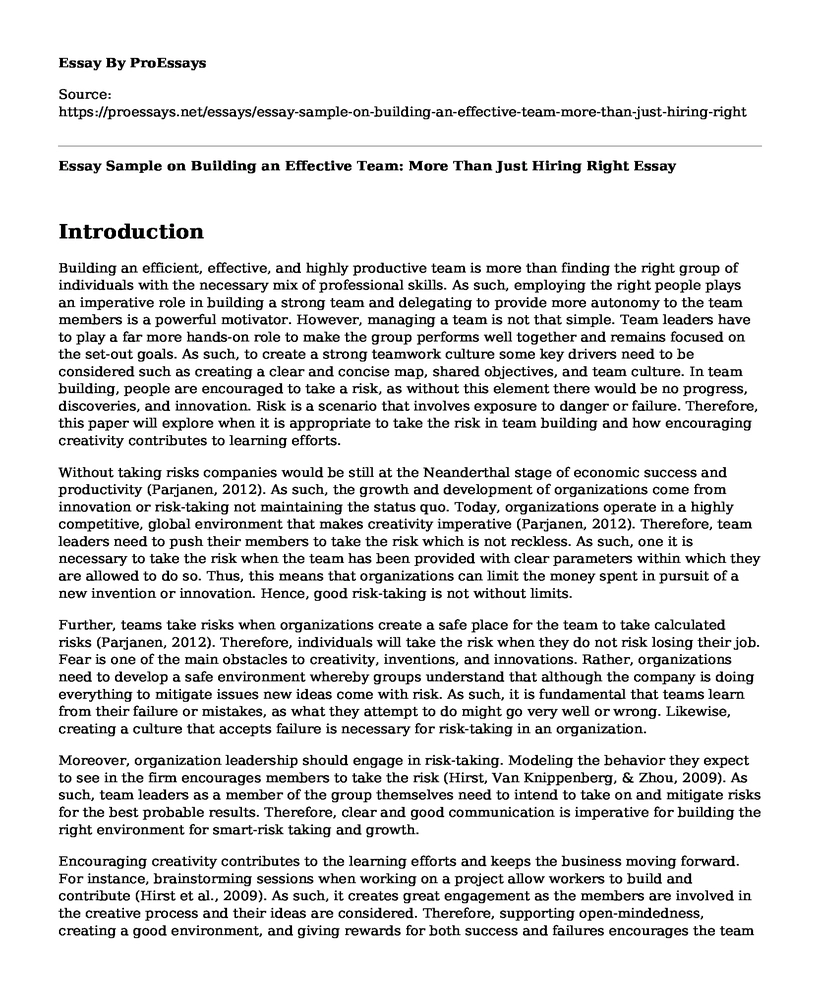Introduction
Building an efficient, effective, and highly productive team is more than finding the right group of individuals with the necessary mix of professional skills. As such, employing the right people plays an imperative role in building a strong team and delegating to provide more autonomy to the team members is a powerful motivator. However, managing a team is not that simple. Team leaders have to play a far more hands-on role to make the group performs well together and remains focused on the set-out goals. As such, to create a strong teamwork culture some key drivers need to be considered such as creating a clear and concise map, shared objectives, and team culture. In team building, people are encouraged to take a risk, as without this element there would be no progress, discoveries, and innovation. Risk is a scenario that involves exposure to danger or failure. Therefore, this paper will explore when it is appropriate to take the risk in team building and how encouraging creativity contributes to learning efforts.
Without taking risks companies would be still at the Neanderthal stage of economic success and productivity (Parjanen, 2012). As such, the growth and development of organizations come from innovation or risk-taking not maintaining the status quo. Today, organizations operate in a highly competitive, global environment that makes creativity imperative (Parjanen, 2012). Therefore, team leaders need to push their members to take the risk which is not reckless. As such, one it is necessary to take the risk when the team has been provided with clear parameters within which they are allowed to do so. Thus, this means that organizations can limit the money spent in pursuit of a new invention or innovation. Hence, good risk-taking is not without limits.
Further, teams take risks when organizations create a safe place for the team to take calculated risks (Parjanen, 2012). Therefore, individuals will take the risk when they do not risk losing their job. Fear is one of the main obstacles to creativity, inventions, and innovations. Rather, organizations need to develop a safe environment whereby groups understand that although the company is doing everything to mitigate issues new ideas come with risk. As such, it is fundamental that teams learn from their failure or mistakes, as what they attempt to do might go very well or wrong. Likewise, creating a culture that accepts failure is necessary for risk-taking in an organization.
Moreover, organization leadership should engage in risk-taking. Modeling the behavior they expect to see in the firm encourages members to take the risk (Hirst, Van Knippenberg, & Zhou, 2009). As such, team leaders as a member of the group themselves need to intend to take on and mitigate risks for the best probable results. Therefore, clear and good communication is imperative for building the right environment for smart-risk taking and growth.
Encouraging creativity contributes to the learning efforts and keeps the business moving forward. For instance, brainstorming sessions when working on a project allow workers to build and contribute (Hirst et al., 2009). As such, it creates great engagement as the members are involved in the creative process and their ideas are considered. Therefore, supporting open-mindedness, creating a good environment, and giving rewards for both success and failures encourages the team members to be creative.
Besides, people perform better when they cooperate. As such, encouraging creativity motivates people to broaden their mental horizons, in the process of learning to be more creative (Hirst et al., 2009). Also, teamwork is crucial when developing new ideas and solutions that are outstanding. Therefore, in an environment where people are in a group and encouraged to be creative, they collect many ideas and decisions. Further, they can build their creative ideas from insights from others.
Conclusion
In conclusion, it is necessary to take risks when organizations want to grow. As such, teams will take the risk when the environment within the industry is safe and members are encouraged to take smart risks. Besides, team leadership should model risk-taking behavior. Encouraging creativity motivates members to learn. For instance, they learn during brainstorming sessions where creativity is feed through questions and insights from other members.
References
Hirst, G., Van Knippenberg, D., & Zhou, J. (2009). A cross-level perspective on employee creativity: Goal orientation, team learning behavior, and individual creativity. Academy of Management Journal, 52(2), 280-293.
Parjanen, S. (2012). Experiencing creativity in the organization: From individual creativity to collective creativity. Interdisciplinary Journal of Information, Knowledge & Management, 7.
Cite this page
Essay Sample on Building an Effective Team: More Than Just Hiring Right. (2023, Apr 08). Retrieved from https://proessays.net/essays/essay-sample-on-building-an-effective-team-more-than-just-hiring-right
If you are the original author of this essay and no longer wish to have it published on the ProEssays website, please click below to request its removal:
- Organizations and People Management Paper Example
- Ecological Crisis: Insufficiency of Dominant Modes of Thought - Essay Sample
- Paper Example With Questions on Organizational Theories
- Project Manager Role: Anxious but Satisfying Job - Essay Sample
- Adapting to Change: Ethical Principles in Change Management - Essay Sample
- Essay on IKEA's Sustainability Strategy: How Well Is It Doing?
- Essay on Virtual Project Management: Working Collaboratively from Distant Locations







